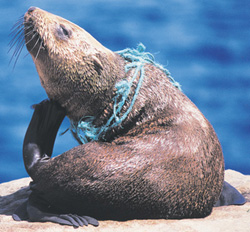Blood on the ice as seal cull returns

Hunters are set to defy protests and slaughter 275,000 pups as seal products make a catwalk comeback - and fur traders eye up the British market.
The world's most notorious bloodbath is about to begin. Next week commercial hunters will start slaughtering more than a quarter of a million seals to supply an international trade in furs and health supplements that will soon target Britain's shops.
Sealers are set to defy international protests by clubbing and shooting more animals than they have for decades, leaving the Atlantic sea ice off Newfoundland stained red. The Canadian goverment has issued licences to shoot or club to death 275,000 harp seals, almost all pups only two weeks old. The massacre has returned with a vengeance in the past four years following 20 years of strict controls imposed after protests. The two-week-old pups are prized for their soft white fur.
The hunters have vowed to proceed despite warnings from environmentalists that the seal population has already been devastated by global warming, which has melted the ice floes on which the mammals give birth. 'There's been a trend of thinning ice - the conditions are appalling,' said Dr Rick Smith, the Canadian director of the International Fund for Animal Welfare.
'The lack of ice means that the seals have been forced to give birth in the water, where their pups drown. We haven't seen a single seal pup yet - that's never happened before.'
Worldwide horror at the hunt led to a boycott of seal fur by most fashion houses and the European Union imposed a ban on certain seal products. To appease animal welfare actitivists, the sealers now try to kill the animals first by shooting them with high-powered rifles, but always carry a club - the hakapik - to smash the skulls of any seals that are still alive.
However, one group of international vets found that four out of five sealers do not check whether seals are dead before skinning them. A deliberate marketing drive by the sealers has pushed up demand for seal fur, meat and oil, with the price of a single pelt jumping from just 5 a few years ago to a record high of about 20.
After years of being taboo, seal fur is making a comeback. Last year the Louis Vuitton collection shown in Paris featured coats, tunics and pinafore dresses made from sealskin. Donatella Versace recently featured sealskin in her first collection.
Helped by Canadian gover ment subsidies, sealers are developing new markets for the by-products of the animal. 'We have four companies producing seal oil capsules - they're better than fish oil, and have a major impact on arthritis,' said Tina Sagan, director of the Canadian Sealers Association.
'There are a couple of companies working on a lotion for eczema and psoriasis. We've good meat products - salami, pepperoni and seal sausage - they are very high in iron and low in fat. We're selling seal leather,' Seal penises are shipped to Asian markets as an aphrodisiac and can sell for up to 200 each. Companies are also making seal protein shakes for sports enthusiasts.
Seal fur is growing in popularity in Greece, Italy and Asia, and the traders will soon tar get British shops. 'There's growing interest in France and Germany for furs and oils. We might try the UK in the next few years - but our approach would have to be a lot softer,' said Sagan. 'I can't see myself coming to London and doing a fahion show with seals.'
The 400-year-old hunt reached its peak in the 1960s, when the collapse of the seal population forced Canada to impose quotas. The international boycott allowed numbers to climb back up to 5.2 million. However, the number of seals being killed has quadrupled in the past four years, and Canadian government scientists estimate the population is declining again by about 1 per cent a year.
'With the lack of sea ice, and huge numbers killed four years in a row, we're killing more than the population can sustain,' said Smith. He insisted the hunt should be banned outright: 'It is allowed to operate in a way that is so inhumane, it is shocking. It is clearly an industry from another century, and should have been relegated to the history books.'
However, Sagan insisted that the species was not threatened. 'We're killing way below replacement level - the herds are not in danger,' she said. 'You eat steak, hamburgers and fish - why shouldn't people eat seal?'
By Anthony Browne
Sunday March 31, 2002
The Observer
MORE



